Akizuki, in Asakura
Akizuki is a former Castle town located in northern part of Asakura. It is a famous spot for
cherry blossom in spring and fall foliage in autumn.
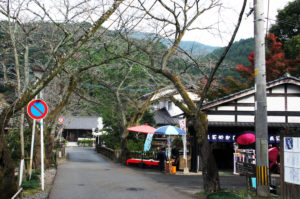 |
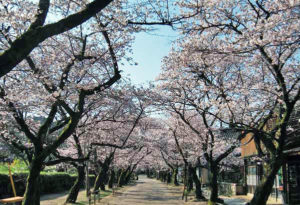 |
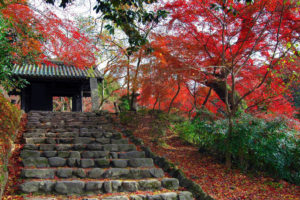 |
You can enjoy the harmony of countryside landscape and former castle town scenery that
makes the atmosphere like a time of 400 years ago.
Japan’s first Seminary
In 1579, Priest Alessandro Valignano of Jesus from Portugal came to Japan to inspect
the situatin of missionary work in Japan.
Valignano believed that training Japanese priests and monks was the key to the success
of missionary work in Japan.
And then, he made the Japan’s first Seminary in Shimabara peninsula in 1580, where was
the Hinoe Castle town of Arima Harunobu.
 |
 |
 |
Among the first students, included member of Tensho youth mission to Europe who were
Ito Mansho Ito, Chijiwa Miguel, Hara Martino and Nakaura Julian.
Note : Seminary is an educational institution established in Japan by the Society of Jesus
between 1580 and 1614 to train Jesuit priests and monks.
Hidden Christian site, Kasuga Village
Kasuga Village and Mount Yasugatake is a Christian Pilgrimage site and is registered on
the World Heritage as Hidden Christian Sites in the Nagasaki Region.
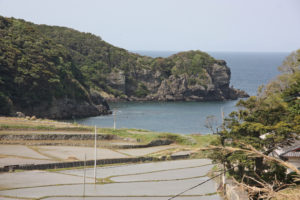 |
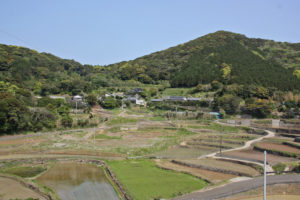 |
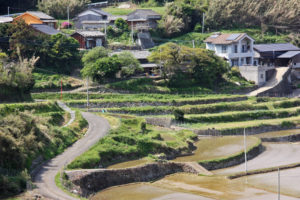 |
This idyllic, remote village was refuge to a small community of Hidden Christians who
practiced here for centuries, far from the prying eyes of the government. After the ban on
Christianity was lifted, the local villagers decided to continue practicing their own unique
brand of the religion rather than rejoin the Catholic Church. As a result, churches were not
erected in the village, and the religion remains outwardly invisible.
Hidden Christians
Oppression against Christians began with the Tokugawa shogunate’s ban
on Christianity. The missionaries were expelled to oversea countries, and
those who remained secretly in Japan were also captured and martyred.
Konishi Mansho who was the last Priest during the ban on Christianity,
was also martyred in 1644.
In the absence of priests, believers pretended to be Shinto or Buddhist
ostensibly in order to protect their faith.
The Christian organizations were created in each village to continue the
Christian faith and the faith was passed down from parents to children and
from children to grandchildren.
 |
 |
 |
Hidden Christian
Even after lifted ban on Christianity, people who continue to practice their
faith in the same way as before are called “Hidden Christians”.
Hidden Christians in Nagasaki have been passed down since the ban on
Christianity in Hirado, Ikitsuki, the Goto Islands, Sotome, and around Nagasaki.
Kurose no Tsuji, martyrdom site of Gaspar Nishi Genka
The site where Christian Gaspar Nishi Genka was martyred in 1609, located on
Kurose Hill overlooking Nakae no shima between Hirado and Ikitsuki.
The tomb facing the sea is called Gaspar-sama and is a revered place for Ikitsuki’s
Hidden Christians.
The cross-shaped “Kurose no Tsuji Martyrdom Monument” was erected by Catholics
in 1991, and Mass is held every year around November 14th.
 |
 |
 |
Gaspar Nishi Genka was the first martyr of Ikitsuki and the father of Thomas Rokuzaemon
Nishi who was one of the 16 Saint of Nagasaki, dedicated in Nakamachi Church in Nagasaki.
Saint Filippo de Jesus Church ( Japan 26 Saints Memorial Church )
This is a church with Gaudi-style twin tower designed by Kenjiro Imai,
built next to the Nishizaka Martyrdom site
 |
 |
 |
When there was a plan to build a memorial hall for the 26 Japanese Saints
next to Nishizaka Martyrdon site, a large donation was made from Mexico,
and the Church was built in 1962.
This church is dedicated to Mexican Filippo de Jesus, who is one of the 26 Saints.
Filippo de Jesus was a Franciscan Catholic missionary who became one of the
26 Martyrs of Japan, the first Mexican Saint.
Oyster Barbecue Hut in Itoshima
Itoshima oyster growing up in the rich nature of mountain and sea Itoshima oyster features
mellow and sweet taste. There are many Oyster Barbecue Huts at five fishing harbours.
The huts only open during the season, from end of October to March or April.
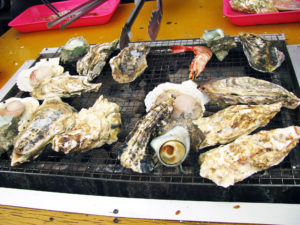 |
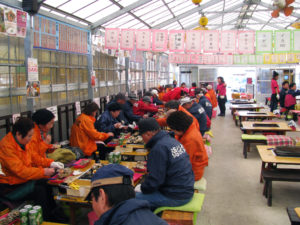 |
 |
The huts are simple in construction; just big vinyl tents filled with a few dozen tables, each with
their own grill. You can get oysters, sazae (sea snails), prawns, fish and other seafood, fresh as
fresh can be, by the crate. The hut provides the grill, tongs, cotton gloves, and other tools for you
try your hand at grilling your own seafood.
Cooking them right can be tricky, but learning is part of the fun. For oysters, try putting the flat side
down first, flip after awhile, and wait for them to open from the heat. Take them off the grill—gloves
on of course—and open them the rest of the way with the provided knife. Add a touch of shoyu
(soy sauce), ponzu (a tangy citrus-based sauce), lemon juice, or mayonnaise if you like and they’re
ready to eat. If you’re unsure how to cook things, just look around at what the other tables are doing
or wave over the helpful kakigoya staff.
Saint Kolbe Memorial Museum, at Hongouchi Church
Father Maximilian Kolbe was born in Poland in 1894 and was a priest of the Conventual
Order of St. Francis.
He had been active in promoting the veneration of the Immaculate Virgin Mary.
He came to Japan in 1930 and began educating seminarians and publishing a monthly
magazine ” the veneration of the Immaculate Virgin Mary.”
After that, the number of Japanese people who understood God’s teachings increased,
and Hongouchi Church was established in 1931.
 |
 |
 |
After six years in Japan, he returned to Poland for health reasons.
And then, he volunteered to die in place of a man named Franciszek Gajowniczek in the
German death camp of Auschwitz, located in German-occupied Poland.
Saint Kolbe Memorial Museum was built to commemorate his canonization in 1986.
Nakamachi Church
Nakamachi Church is located near JR Nagasaki Station which was constructed
for Japanese Christians in 1986.
The church was dedicated to the 16 Saints of Nagasaki (St. Thomas and the 15 Martyrs)
in 1988, and the monument honoring them was erected in the premise.
The 16 Saints were martyred in Nagasaki from 1633 to 1637.
 |
 |
 |
The 16 martyrs became Saints in 1987, since 26 Saint.
Dominic Ibáñez de Erquicia Pérez de Lete, Spanish, 1633, Dominican Priest
Antonio Gonzalez, Spanish, 1637, Dominican Priest
Jordan Ansalone, Italian, 1634, Dominican Priest
Luke of the Holy Spirit Alonso Gorda, Spanish, 1633, Dominican Priest
Michael de Aozaraza, Spanish, 1637, Dominican Priest
Guillaume Courtet, French, 1637, Dominican Priest
Jacobo Kyushei Gorōbyōe Tomonaga de Santa María, Japanese, 1633, Dominican Priest
Thomas Rokuzayemon Nishi, Japanese, 1634, Dominican Priest
Vincent Shiwozuka, Japanese, 1637, Dominican Priest
Francis Shōyemon, Japanese, 1633
Matthew Kohioye, Japanese, 1633
Lorenzo Ruiz, Filipino, 1637
Marina of Omura, Japanese, 1634
Magdalene of Nagasaki, Japanese, 1634
Michael Kurobioye, Japanese, 1633
Lazarus of Kyoto, Japanese, 1637
Yoshii, Shirakabe-dori Avenue
Shirakabe-dori Avenue is located in Yoshii, Ukiha-city
Time-honored scenery, back to 100 years ago. The Avenue is located in Yoshii-machi,
Ukiha-city. Shirakabe, literary meaning is white wall. The avenue of houses with white
wall were constructed about 100 years ago. About 250 houses in the area has been
designated as National important traditional buildings preservation district.
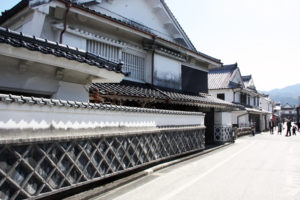 |
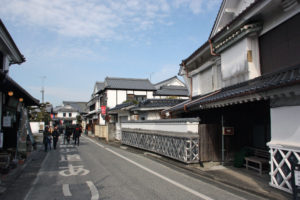 |
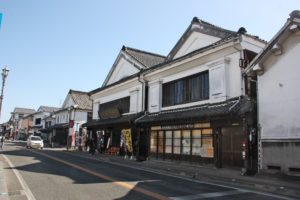 |
Featured Restaurant, Shirakabe
The restaurant Shirakabe is in the former merchant’s building constructed in 1928. Japanese
cuisines using best local ingredients that vary by season can be enjoyed. The chef who makes
that cuisines also experienced the imperial family’s cook.
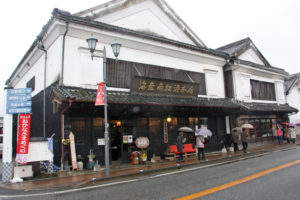 |
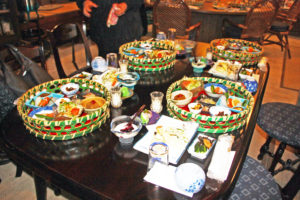 |
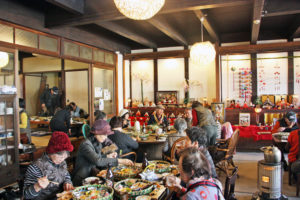 |
